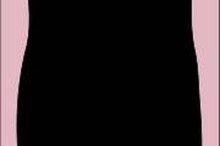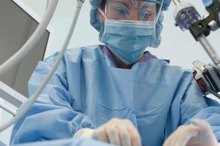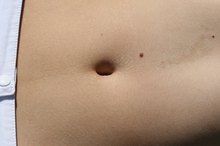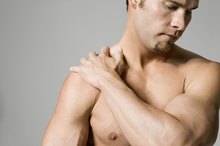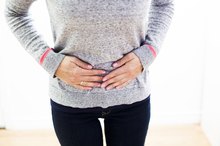Gall Bladder Symptoms in Women
You just finished dinner and you have a sudden, sharp pain in your upper side that spreads to your right shoulder. It hurts when you inhale and you feel nauseous. These symptoms may signal a problem with your gallbladder, a small organ tucked beneath your liver that helps to feed bile to your intestines to help you digest your food. (1) While women may experience similar gallbladder symptoms to men, they are more likely to develop gallbladder problems, which may be triggered by pregnancy, rapid weight loss, or medications that contain estrogen, among other risk factors, according to the American Family Physician (AFP) (2).
If you are experiencing serious medical symptoms, seek emergency treatment immediately.
Understanding biliary colic
Often the first sign of a gallbladder problem is biliary colic, which is a type of gallbladder pain. It most often starts in the upper right part of your abdomen and may wrap around to your back or arm, according to The Merck Manual for Health Care Professionals 356. (3) For some women, this pain may be more generalized. Gallbladder-related pain typically comes on fast, rapidly intensifies, then stabilizes. It can last for up to 12 hours, when it tapers off to a dull ache (3). Many women with biliary colic may also feel sick to their stomach or vomit. (3) The pain of biliary colic is usually the result of gallbladder inflammation, known as cholecystitis, most often caused by a gallstone 6. Gallstones occur when the substances inside your gallbladder that make bile become imbalanced and form a hard, grainy cluster that can range in size from a tiny granule to the size of a golf ball. (4). These hard stones can inflame the gallbladder or block the flow of bile, triggering symptoms. But stones aren't the only cause of gallbladder symptoms or inflammation. Gallbladder symptoms can also arise from structural or functional problems with your gallbladder as well, according to The Merck Manual for Healthcare Professionals 356. (5)
Symptoms of an acute attack
Appendix Stones Symptoms
Learn More
In some cases, gallbladder pain can mimic other conditions, such as a heart attack, so it’s important to confirm your diagnosis with your doctor. (3) Acute cholecystitis often occurs when a gallstone blocks the flow of bile, although between five and 10 percent of people with acute cholecystitis don’t have a stone, according to the Merck Manual for Health Care Professionals 356. (6) Another sign of acute cholecystitis is increased pain when you inhale as your doctor presses on your upper right abdomen 6. (6)
An Acute Attack or Biliary Colic
In addition to pain and fever, women with more severe gallbladder disease may also experience other symptoms, such as a yellowing of the skin, called jaundice. (7)
In rare cases, jaundice and other gallbladder symptoms may be caused by gallbladder cancer, according to the Merck Manual for Health Care Professionals 356. Recurrent gallbladder symptoms may signal a chronic gallbladder problem called chronic cholecystitis, which can damage your gallbladder, and affect its ability to function. (10)
Diagnosing and treating the problem
Pain in the Upper Right Back After Eating
Learn More
If your doctor suspects that you have a problem with your gallbladder, she will likely recommend an ultrasound or other imaging procedure to determine if you have a stone, according to the University of Maryland Medical Center 9. (9) Ultrasound is very effective at detecting stones as small as 2 mm, (9) however, it is not always able to detect stones located in a bile duct. Laboratory tests, however, can be used to detect these stones. Lab tests may reveal elevated levels of bilirubin or liver enzymes in women with these stones or who have acute cholecystitis 6. (9) Typically laboratory results are normal in patients with biliary colic. (9) Depending on the findings of imaging examinations and laboratory tests, your doctor may recommend surgery to remove your gallbladder, which is the most common treatment method for gallbladder disease. (9) In other cases she may recommend surgery to remove the stones or prescribe medication to dissolve them, according to the American College of Gastroenterology (2). The good news is, your body can function well without your gallbladder, and once your gallbladder or stones are gone, you won't likely have to suffer through the pain of future attacks.
Related Articles
References
- Journal of the American Medical Association, Acute Cholecystitis
- American Family Physician, Diagnosing Biliary Colic and Acute Cholecystitis
- The Merck Manual for Health Care Professionals: Cholelithiasis
- The Merck Manual for Health Care Professionals: Acalculous Bilary Pain
- The Merck Manual: Acute Cholecystitis
- The Merck Manual, Choledocholithiasis and Cholangitis.
- The The Merck Manual for Health Care Professionals: Tumors of the Gallbladder and Bile Ducts
- University of Maryland Medical Center: Gallstones and Gallbladder Disease
- The Merck Manual for Health Care Professionals: Chronic cholecystitis
- National Institute of Diabetes and Digestive and Kidney Diseases. (n.d.). Gallstones. https://www.niddk.nih.gov/health-information/digestive-diseases/gallstones
- University of Maryland Medical Center. (2018). Gallstones and gallbladder disease. https://www.umms.org/ummc/patients-visitors/health-library/in-depth-patient-education-reports/articles/gallstones-and-gallbladder-disease
- Njeze GE. Gallstones. Niger J Surg. 2013;19(2):49-55. doi:10.4103/1117-6806.119236
- Maurer KJ, Carey MC, Fox JG. Roles of infection, inflammation, and the immune system in cholesterol gallstone formation. Gastroenterology. 2009;136(2):425-40. doi:10.1053/j.gastro.2008.12.031
- Halpin V. Acute cholecystitis. BMJ Clin Evid. 2014;2014:0411.
- Balmadrid B. Recent advances in management of acalculous cholecystitis. F1000Res. 2018;7: F1000 Faculty Rev-1660. doi:10.12688/f1000research.14886.1
- Ahmed M. Acute cholangitis - an update. World J Gastrointest Pathophysiol. 2018;9(1):1-7. doi:10.4291/wjgp.v9.i1.1
- Derici H, Kara C, Bozdag AD, Nazli O, Tansug T, Akca E. Diagnosis and treatment of gallbladder perforation. World J Gastroenterol. 2006;12(48):7832-6. doi:10.3748/wjg.v12.i48.7832
- Toouli J. Biliary Dyskinesia. Curr Treat Options Gastroenterol. 2002;5(4):285-291.
- Ahmed M, Diggory R. Acalculous gallbladder disease: the outcomes of treatment by laparoscopic cholecystectomy. Ann R Coll Surg Engl. 2011;93(3):209-12. doi:10.1308/003588411X563402
- Shaffer EA. Gallbladder cancer: the basics. Gastroenterol Hepatol (N Y). 2008;4(10):737-41.
- Wang JK, Foster SM, Wolff BG. Incidental gallstones. Perm J. 2009;13(2):50-4.
- Bree RL. Further observations on the usefulness of the sonographic Murphy sign in the evaluation of suspected acute cholecystitis. J Clin Ultrasound. 1995;23(3):169-72.
- Robinson P, Perkins JC. Approach to Patients with Epigastric Pain. Emerg Med Clin North Am. 2016;34(2):191-210. doi:10.1016/j.emc.2015.12.012
- Pejić MA, Milić DJ. [Surgical treatment of polypoid lesions of gallbladder]. Srp Arh Celok Lek. 2003;131(7-8):319-24.
- Genc V, Sulaimanov M, Cipe G, et al. What necessitates the conversion to open cholecystectomy? A retrospective analysis of 5164 consecutive laparoscopic operations. Clinics (Sao Paulo). 2011;66(3):417-20. doi:10.1590/S1807-59322011000300009
- Katzarov AK, Dunkov ZI, Popadiin I, Katzarov KS. How to measure quality in endoscopic retrograde cholangiopancreatography (ERCP). Ann Transl Med. 2018;6(13):265. doi:10.21037/atm.2018.05.01
- Catalano MF, Thosani NC. (2016). Clinical manifestations and diagnosis of sphincter of Oddi dysfunction. Howell DA (ed). UpToDate, Waltham, MA: UpToDate Inc.
- Lee JY, Keane MG, Pereira S. Diagnosis and treatment of gallstone disease. Practitioner. 2015 Jun;259(1783):15-9,2.
- National Institute of Diabetes and Digestive and Kidney Diseases. (n.d.). Gallstones.
- University of Maryland Medical Center. (2018). Gallstones and gallbladder disease.
Resources
Writer Bio
J. Lucy Boyd, RN, BSN has written several nonfiction books including "The Complete Guide to Healthy Cooking and Nutrition for College Students." She is frequently called upon to provide career guidance to medical professionals and advice to parents of children with challenges. She also loves teaching others to cook for their families.
